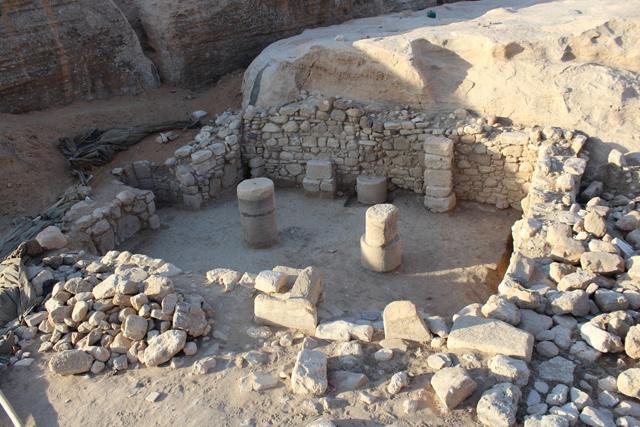You are here
Archaeological project explores Beidha during Islamic era
By Saeb Rawashdeh - Dec 04,2017 - Last updated at Dec 04,2017

The Shara Mountain seen from the Islamic Beidha archaeological site (Photo courtesy of Micaela Sinibaldi)
AMMAN — The Islamic Beidha Project was launched in 2014, under the direction of Italian archaeologist Micaela Sinibaldi, to conduct excavations, surveys, conservation projects and enhance community engagement focusing on the Islamic village at Beidha studied in the broader context of the Beidha and Petra regions.
“The Islamic Beidha Project has concluded its fourth season in November 2017 and is currently affiliated with the Council for British Research in the Levant,” Sinibaldi, who is affiliated with Cardiff University in the UK told The Jordan Times in an e-mail interview.
The Islamic village of Beidha (“the white one”, a name originating from the white colour of the local sandstone), is located near Siq Al Barid, the so-called Little Petra, and it is part of the Petra region, she continued.
“The study of Islamic Beidha belongs to a broader project — The Late Petra Project, which I lead — which explores the post-Byzantine period in Petra and is aimed at filling an important gap in the history of the region by expanding research both to the hinterland of Petra and of its later periods,” the archaeologist noted.
Contrary to traditional theories, the Petra Valley was “never really abandoned”, she claimed, adding that, starting from the Byzantine period, there was a gradual movement of most of the population living inside the valley to outside areas, in search for better opportunities for water and agriculture.
“During this time, the Beidha region included several agricultural villages, because of its position under the Shara Mountains, particularly favourable for agriculture since the time of Neolithic Beidha,” Sinibaldi explained.
The landscape of Beidha during the Islamic period was composed of a network of villages, which Sinibaldi is currently working on, including the Islamic village at Baja, also dated to the Late Islamic period, whose study is currently being published.
According to Sinibaldi, diachronic patterns of settlement can be identified in the whole Petra area, based on the analysis of their ceramics from various surveys. The insights provided by the surveys, which followed her creation of a regional ceramic chronology, now allows a diachronical analysis of the history of the Petra hinterland’ landscape.
“In the Beidha area, for example, settlement of the Late Islamic period appears more intense than during the Middle Islamic period,” the researcher said.
Archaeology at the Beidha Islamic village is of crucial importance for exploring this period in the Petra region, she elaborated, stressing that “although at this time, Wadi Musa was the main centre outside the Petra Valley, its fast, recent development makes it now almost impossible to conduct archaeological excavations in the city”.
The rural village has been settled probably over the whole Islamic period, following a large settlement during the Nabataean and Byzantine periods, Sinibaldi argued, adding that the Islamic village at Beidha consists of clusters of habitations, largely belonging to the Late Islamic period, and of two mosques.
“Results of the 2014-2017 seasons include the recovery of a 14th century coin from Cairo, which suggests that at this time there was at least frequentation of the village, and the study of the two mosques of the village,” the Italian scholar said.
These are the only two mosques ever excavated in Petra, and therefore an important opportunity to study the architecture of Islamic-period rural mosques in the region, she underscored.
The use of the Archaeology of Standing Buildings on the mosques has revealed many details of their architecture, building styles and phasing. “At least one was largely decorated with painted plaster and both were built by reusing remains of former, probably Nabataean structures,” she highlighted.
“One of them, which would serve about 40 worshippers, is in a very good state of preservation and is now ready for conservation and presentation to the public,” Sinibaldi said.
As part of its community engagement programme, the project is also regularly conducting an initiative involving schools of the Petra region, in partnership with the Petra Archaeological Park, the scholar underlined.
“Future plans for the Islamic Beidha Project include carrying on excavations at the village to find out more about its structure, development and daily life throughout the Islamic period,” Sinibaldi explained, adding “they also include comparing these results with the ones from similar neighbouring sites by using same methodology of study. Finally, there are plans for fundraising for the conservation and presentation of at least the two mosques.”
Related Articles
AMMAN — The Late Petra Project focuses on a settlement in the Petra region occupied after the Byzantine period, ca.
AMMAN — In contrast with the area of Wadi Musa, Beidha is still free from modern development, so the natural landscape is still unspoiled an
AMMAN — An expert in Jordan's mediaeval history has challenged popular beliefs about the 12th-century Crusader occupation, arguing that the













